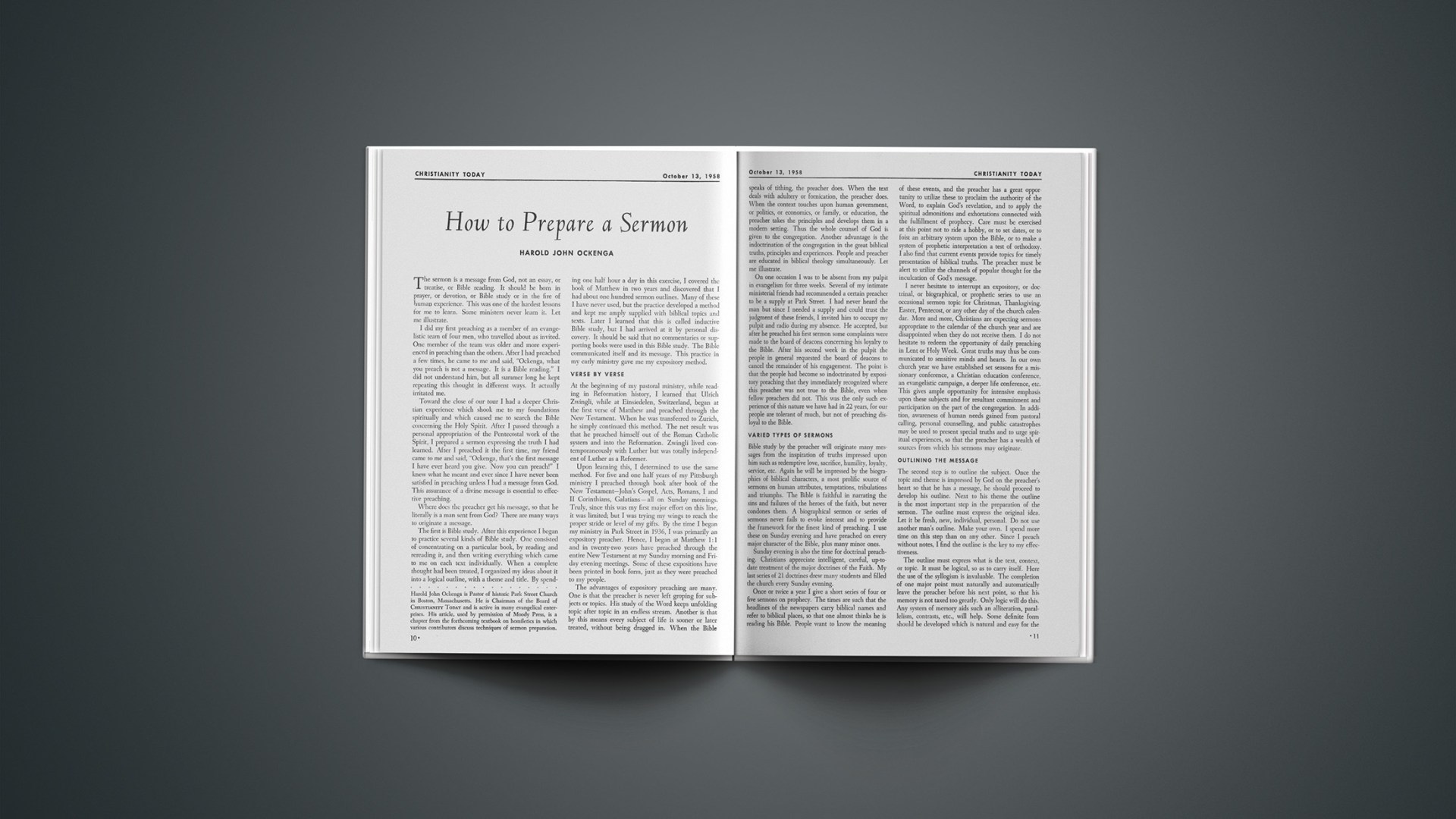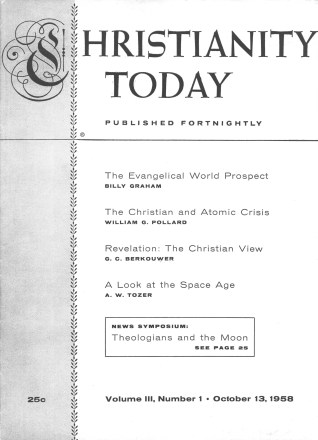The sermon is a message from God, not an essay, or treatise, or Bible reading. It should be born in prayer, or devotion, or Bible study or in the fire of human experience. This was one of the hardest lessons for me to learn. Some ministers never learn it. Let me illustrate.
I did my first preaching as a member of an evangelistic team of four men, who travelled about as invited. One member of the team was older and more experienced in preaching than the others. After I had preached a few times, he came to me and said, “Ockenga, what you preach is not a message. It is a Bible reading.” I did not understand him, but all summer long he kept repeating this thought in different ways. It actually irritated me.
Toward the close of our tour I had a deeper Christian experience which shook me to my foundations spiritually and which caused me to search the Bible concerning the Holy Spirit. After I passed through a personal appropriation of the Pentecostal work of the Spirit, I prepared a sermon expressing the truth I had learned. After I preached it the first time, my friend came to me and said, “Ockenga, that’s the first message I have ever heard you give. Now you can preach!” I knew what he meant and ever since I have never been satisfied in preaching unless I had a message from God. This assurance of a divine message is essential to effective preaching.
Where does the preacher get his message, so that he literally is a man sent from God? There are many ways to originate a message.
The first is Bible study. After this experience I began to practice several kinds of Bible study. One consisted of concentrating on a particular book, by reading and rereading it, and then writing everything which came to me on each text individually. When a complete thought had been treated, I organized my ideas about it into a logical outline, with a theme and title. By spending one half hour a day in this exercise, I covered the book of Matthew in two years and discovered that I had about one hundred sermon outlines. Many of these I have never used, but the practice developed a method and kept me amply supplied with biblical topics and texts. Later I learned that this is called inductive Bible study, but I had arrived at it by personal discovery. It should be said that no commentaries or supporting books were used in this Bible study. The Bible communicated itself and its message. This practice in my early ministry gave me my expository method.
Verse By Verse
At the beginning of my pastoral ministry, while reading in Reformation history, I learned that Ulrich Zwingli, while at Einsiedelen, Switzerland, began at the first verse of Matthew and preached through the New Testament. When he was transferred to Zurich, he simply continued this method. The net result was that he preached himself out of the Roman Catholic system and into the Reformation. Zwingli lived contemporaneously with Luther but was totally independent of Luther as a Reformer.
Upon learning this, I determined to use the same method. For five and one half years of my Pittsburgh ministry I preached through book after book of the New Testament—John’s Gospel, Acts, Romans, I and II Corinthians, Galatians—all on Sunday mornings. Truly, since this was my first major effort on this line, it was limited; but I was trying my wings to reach the proper stride or level of my gifts. By the time I began my ministry in Park Street in 1936, I was primarily an expository preacher. Hence, I began at Matthew 1:1 and in twenty-two years have preached through the entire New Testament at my Sunday morning and Friday evening meetings. Some of these expositions have been printed in book form, just as they were preached to my people.
The advantages of expository preaching are many. One is that the preacher is never left groping for subjects or topics. His study of the Word keeps unfolding topic after topic in an endless stream. Another is that by this means every subject of life is sooner or later treated, without being dragged in. When the Bible speaks of tithing, the preacher does. When the text deals with adultery or fornication, the preacher does. When the context touches upon human government, or politics, or economics, or family, or education, the preacher takes the principles and develops them in a modern setting. Thus the whole counsel of God is given to the congregation. Another advantage is the indoctrination of the congregation in the great biblical truths, principles and experiences. People and preacher are educated in biblical theology simultaneously. Let me illustrate.
On one occasion I was to be absent from my pulpit in evangelism for three weeks. Several of my intimate ministerial friends had recommended a certain preacher to be a supply at Park Street. I had never heard the man but since I needed a supply and could trust the judgment of these friends, I invited him to occupy my pulpit and radio during my absence. He accepted, but after he preached his first sermon some complaints were made to the board of deacons concerning his loyalty to the Bible. After his second week in the pulpit the people in general requested the board of deacons to cancel the remainder of his engagement. The point is that the people had become so indoctrinated by expository preaching that they immediately recognized where this preacher was not true to the Bible, even when fellow preachers did not. This was the only such experience of this nature we have had in 22 years, for our people are tolerant of much, but not of preaching disloyal to the Bible.
Varied Types Of Sermons
Bible study by the preacher will originate many messages from the inspiration of truths impressed upon him such as redemptive love, sacrifice, humility, loyalty, service, etc. Again he will be impressed by the biographies of biblical characters, a most prolific source of sermons on human attributes, temptations, tribulations and triumphs. The Bible is faithful in narrating the sins and failures of the heroes of the faith, but never condones them. A biographical sermon or series of sermons never fails to evoke interest and to provide the framework for the finest kind of preaching. I use these on Sunday evening and have preached on every major character of the Bible, plus many minor ones.
Sunday evening is also the time for doctrinal preaching. Christians appreciate intelligent, careful, up-to-date treatment of the major doctrines of the Faith. My last series of 21 doctrines drew many students and filled the church every Sunday evening.
Once or twice a year I give a short series of four or five sermons on prophecy. The times are such that the headlines of the newspapers carry biblical names and refer to biblical places, so that one almost thinks he is reading his Bible. People want to know the meaning of these events, and the preacher has a great opportunity to utilize these to proclaim the authority of the Word, to explain God’s revelation, and to apply the spiritual admonitions and exhortations connected with the fulfillment of prophecy. Care must be exercised at this point not to ride a hobby, or to set dates, or to foist an arbitrary system upon the Bible, or to make a system of prophetic interpretation a test of orthodoxy. I also find that current events provide topics for timely presentation of biblical truths. The preacher must be alert to utilize the channels of popular thought for the inculcation of God’s message.
I never hesitate to interrupt an expository, or doctrinal, or biographical, or prophetic series to use an occasional sermon topic for Christmas, Thanksgiving, Easter, Pentecost, or any other day of the church calendar. More and more, Christians are expecting sermons appropriate to the calendar of the church year and are disappointed when they do not receive them. I do not hesitate to redeem the opportunity of daily preaching in Lent or Holy Week. Great truths may thus be communicated to sensitive minds and hearts. In our own church year we have established set seasons for a missionary conference, a Christian education conference, an evangelistic campaign, a deeper life conference, etc. This gives ample opportunity for intensive emphasis upon these subjects and for resultant commitment and participation on the part of the congregation. In addition, awareness of human needs gained from pastoral calling, personal counselling, and public catastrophes may be used to present special truths and to urge spiritual experiences, so that the preacher has a wealth of sources from which his sermons may originate.
Outlining The Message
The second step is to outline the subject. Once the topic and theme is impressed by God on the preacher’s heart so that he has a message, he should proceed to develop his outline. Next to his theme the outline is the most important step in the preparation of the sermon. The outline must express the original idea. Let it be fresh, new, individual, personal. Do not use another man’s outline. Make your own. I spend more time on this step than on any other. Since I preach without notes, I find the outline is the key to my effectiveness.
The outline must express what is the text, context, or topic. It must be logical, so as to carry itself. Here the use of the syllogism is invaluable. The completion of one major point must naturally and automatically leave the preacher before his next point, so that his memory is not taxed too greatly. Only logic will do this. Any system of memory aids such an alliteration, parallelism, contrasts, etc., will help. Some definite form should be developed which is natural and easy for the individual. Then that form of sermon structure should be followed. I generally have an introduction, three major points, and a conclusion, with three subpoints under each section, all in alliteration. All this is part of the outline and is designed to keep me from forgetting and to impress the message on the hearer. Let me illustrate.
My friend, Dr. Wilbur Smith, preached a very unusual and impressive Mother’s Day sermon on Proverbs 31, dealing with a virtuous woman. I was thinking about it a few days later. The sermon had four points. I could remember three, the first, second and last, but for the life of me, I couldn’t remember the third even though I knew the verses on which it was based. At a reception that same week I asked Dr. Smith to review his points for me. He did but said he could not remember the third point. The others were Industry, Fidelity and Sympathy, but neither of us could remember the third.
A few days later he saw me and said, “Now I remember. It was Personal Interest.” I said, “Why didn’t you give it a title like Courtesy or Generosity to achieve parallelism so we could remember it?” He replied, “Oh, I didn’t have time for that. It was coincidental that the others were parallel.”
I pointed out to him that this was the reason neither he, the preacher, nor I, the hearer, could remember the third point in the passage of Scripture. No man can preach without notes unless he observes these rules concerning his outline. Put time into it, for it will repay you. In addition, outline your conclusion first, so that you always keep in mind your goal, your aim, your purpose, and then you will not be shooting at random.
Obtaining Material
The third step is the obtaining of material for the sermon. Some people place this second or even first but that is a mistake, for it ruins originality or spoils logical development. When the topic and theme are chosen, and the outline is logically forged, then is the time to gather material for the flesh on the bones. Reading in the original languages or versions should be completed in connection with the outline. If this has not been done, it must be done now. The nuances of meaning of the biblical text must be mastered and often they throw much light and provide much material. The related texts and passages of Scripture bearing on the subject must be examined and used here.
Next the student should examine his file for general material, illustrations, and library references for material throwing light upon his topic and theme. Finally, let him refer to commentaries, critical and practical, to ascertain whether he has missed anything important by way of emphasis or teaching. The content of the sermon depends upon the thoroughness of this third step. Often I never get to the commentaries at all, for I have a complete message without them. I am much happier when this is the case.
The fourth step is to re-outline the message in the light of the material gathered. The process pertains only to the subheads of your own outline. If the original work was done well, the remaining work will be very minor. But it is wise to re-examine the outline in the light of all available facts and information.
The fifth step is to write out or dictate the sermon. For the first 15 years of my ministry, I wrote or dictated every sermon. This develops the preachers’ style. Vocabulary, phraseology, sentence structure, figures of speech, etc., come from work in writing. Once this is established firmly the preacher may abandon the practice. Now my sermons are all recorded on tape and disc, but often I dictate a message for printing. The ease with which this is done is the result of 15 years of early labor in forming a method, a style, and a facility. At this stage I dictate all the books I write. It is easier for me to dictate than to write, for my thoughts flow faster than I can write them.
Outline Memorized
The sixth step in preparation is to memorize the outline. I have to prepare and deliver three major sermons and two minor addresses in Park Street Church every week, besides all outside speaking engagements. I prepare my Sunday evening sermon first. Next, I prepare my Friday night exposition. Finally, I prepare my Sunday morning sermon. Thus it is easier for delivery. I deliver the Friday night lecture while it is fresh in my mind. Then I work Saturday on the Sunday morning sermon, finishing it and getting it in mind to deliver. On Sunday afternoon I revert to the evening sermon which was prepared first in the week, getting it in mind to preach without notes. In this way I unload my mind in the reverse order of preparation and avoid confusion. It takes me about two hours to memorize my outline. While I do this memory work, I bathe my heart and mind in prayer. The ease with which one memorizes will depend upon the care with which he made his outline.
The seventh and last step is to preach the sermon. Leave manuscript, notes and material on your desk when you enter the pulpit. Enter with a trust that God will bring all things to your mind which you knew. What He wants you to forget, let go by. What He wants to amplify, He can do by the power of suggestion. Thus you have liberty in preaching, direct address to the people, and give sway to the work of the Holy Spirit. This has been my method for 30 years of preaching without notes and no doubt will be as long as God allows me the great privilege of expounding the unsearchable riches of Christ.
END
Harold John Ockenga is Pastor of historic Park Street Church in Boston, Massachusetts. He is Chairman of the Board of Christianity Today and is active in many evangelical enterprises. His article, used by permission of Moody Press, is a chapter from the forthcoming textbook on homiletics in which various contributors discuss techniques of sermon preparation.










